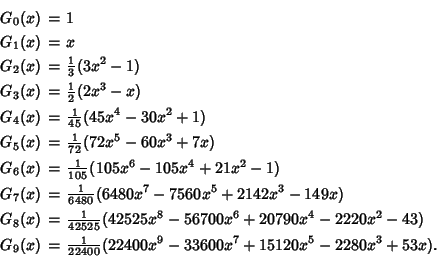|
|
|
A Gaussian Quadrature-like Formula for numerical estimation of integrals. It uses Weighting Function
![]() in the interval
in the interval ![]() and forces all the weights to be equal. The general Formula is
and forces all the weights to be equal. The general Formula is




| 2 | ± 0.57735 |
| 3 | 0 |
| ± 0.707107 | |
| 4 | ± 0.187592 |
| ± 0.794654 | |
| 5 | 0 |
| ± 0.374541 | |
| ± 0.832497 | |
| 6 | ± 0.266635 |
| ± 0.422519 | |
| ± 0.866247 | |
| 7 | 0 |
| ± 0.323912 | |
| ± 0.529657 | |
| ± 0.883862 | |
| 9 | 0 |
| ± 0.167906 | |
| ± 0.528762 | |
| ± 0.601019 | |
| ± 0.911589 |
The Abscissas and weights can be computed analytically for small ![]() .
.
| 2 |
|
| 3 | 0 |
|
|
|
| 4 |
|
|
|
|
| 5 | 0 |
 |
|
 |
See also Chebyshev Quadrature, Lobatto Quadrature
References
Beyer, W. H. CRC Standard Mathematical Tables, 28th ed. Boca Raton, FL: CRC Press, p. 466, 1987.
Hildebrand, F. B. Introduction to Numerical Analysis. New York: McGraw-Hill, pp. 345-351, 1956.
|
|
|
© 1996-9 Eric W. Weisstein